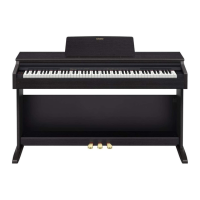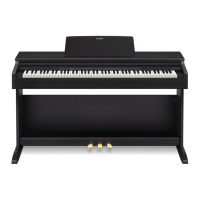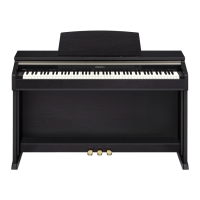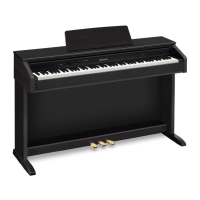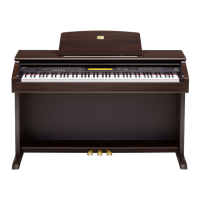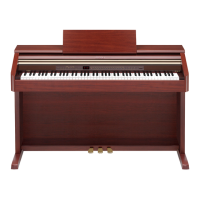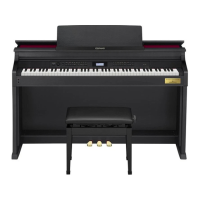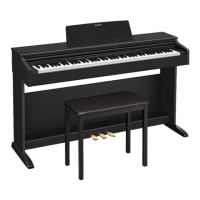Do you have a question about the Casio Celviano AP-60R and is the answer not in the manual?
Warnings about electric shock, servicing, and symbol meanings.
Instructions for safe power source selection and power cord handling.
Warnings about instrument placement, liquids, objects, and cover operation.
Guidelines for safe operation, handling malfunctions, and product damage.
Warnings about plastic bags and general child safety around the product.
Precautions for power cord placement, unplugging, and wet hands.
Warnings about placement, weight, stability, and surface protection.
Advice on safe volume levels to prevent hearing damage.
Guidelines for handling the Liquid Crystal Display to prevent damage or injury.
Advice on avoiding specific locations for optimal performance and safety.
Instructions for cleaning, handling, and general care of the unit.
Information about the lithium battery for memory retention and replacement.
Procedure to reset the piano to factory default settings, deleting all data.
Guide for connecting to external audio systems for sound output.
Instructions for connecting headphones for private practice.
Guide for connecting to an amplifier for louder sound output.
Initial steps to power on and play the piano.
How to choose different instrument sounds using TONE buttons.
How to choose and set a rhythm pattern for accompaniment.
Guide to using the feature that plays bass and chord parts automatically.
How to adjust the sensitivity of key presses to volume.
How to select tones using the Mixer function.
Overview of storing and recalling piano settings.
Advanced settings for channel parameters like program change, effect send.
Step-by-step guide for recording directly to Track 1.
Step-by-step guide for correcting or overdubbing Track 1 using punch-in.
Guide for punch-in recording for Tracks 2-6.
Step-by-step guide for recording a new accompaniment pattern.
How to play Standard MIDI Files from a diskette.
Steps to select and play individual MIDI files.
How to play back all files on a diskette sequentially.
How to transfer all piano data to an external device via MIDI.
How to receive bulk data from an external device into the piano.
Step-by-step guide for assembling the piano stand.
Warnings about electric shock, servicing, and symbol meanings.
Instructions for safe power source selection and power cord handling.
Warnings about instrument placement, liquids, objects, and cover operation.
Guidelines for safe operation, handling malfunctions, and product damage.
Warnings about plastic bags and general child safety around the product.
Precautions for power cord placement, unplugging, and wet hands.
Warnings about placement, weight, stability, and surface protection.
Advice on safe volume levels to prevent hearing damage.
Guidelines for handling the Liquid Crystal Display to prevent damage or injury.
Advice on avoiding specific locations for optimal performance and safety.
Instructions for cleaning, handling, and general care of the unit.
Information about the lithium battery for memory retention and replacement.
Procedure to reset the piano to factory default settings, deleting all data.
Guide for connecting to external audio systems for sound output.
Instructions for connecting headphones for private practice.
Guide for connecting to an amplifier for louder sound output.
Initial steps to power on and play the piano.
How to choose different instrument sounds using TONE buttons.
How to choose and set a rhythm pattern for accompaniment.
Guide to using the feature that plays bass and chord parts automatically.
How to adjust the sensitivity of key presses to volume.
How to select tones using the Mixer function.
Overview of storing and recalling piano settings.
Advanced settings for channel parameters like program change, effect send.
Step-by-step guide for recording directly to Track 1.
Step-by-step guide for correcting or overdubbing Track 1 using punch-in.
Guide for punch-in recording for Tracks 2-6.
Step-by-step guide for recording a new accompaniment pattern.
How to play Standard MIDI Files from a diskette.
Steps to select and play individual MIDI files.
How to play back all files on a diskette sequentially.
How to transfer all piano data to an external device via MIDI.
How to receive bulk data from an external device into the piano.
Step-by-step guide for assembling the piano stand.
| Type | Digital Piano |
|---|---|
| Number of Keys | 88 |
| Touch Sensitivity | 3 Levels |
| Sounds | 10 |
| Effects | Reverb, Chorus |
| Weight | 45 kg |
| Keyboard | Weighted Hammer Action |
| Sound Source | AHL (Acoustic & Highly-compressed Large-waveform) |
| Tones | 10 |
| Speaker Size | 12cm x 2 |
| Pedals | 3 (Damper, Soft, Sostenuto) |


